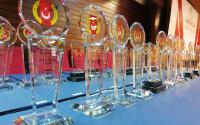6 August 2003The Guardian
One of Europe's leading scientists yesterday raised the possibility that the extreme heatwave now settled over at least 30 countries in the northern hemisphere could signal that man-made climate change is accelerating.
"The present heatwave across the northern hemisphere is worrying. There is the small probability that man-made climate change is proceeding much faster and stronger than expected," said Professor John Schellnhuber, former chief scientific adviser to the German government and now head of the UK's leading group of climate scientists at the Tyndall centre.
Prof Schellnhuber said "the parching heat experienced now" could be consistent "with a worst-case scenario [of global warming] that nobody wants to come true". He warned that several months' research would be needed to analyse data from around the world before scientists could say why the heatwaves are so intense this year.
"What we are seeing is absolutely unusual," said Prof Schellnhuber. "We know that global warming is proceeding apace, but most of us were thinking that in 20-30 years time we would be seeing hot spells [like this]. But it's happening now. Clearly extreme weather events will increase."
Other climate scientists across Europe suggested the present heatwave was perhaps the most intense experienced and linked to global warming.
"We've not seen such an extended period of dry weather [in Europe] since records began," said Michael Knobelsdorf, a meteorologist at the German weather service. "What's remarkable is that these extremes of weather are happening at such short intervals, which suggests the climate is unbalanced. Last year in Germany, we were under water. Now we have one of the worst droughts in human memory."
Antonio Navarra, chief climatologist at Italy's National Geophysics Institute, said the Mediterranean region was 2-3C warmer than usual this summer.
Temperatures across parts of Europe have been a consistent 5C warmer than average for several months, but the heatwaves have extended across the northern hemisphere. Temperatures in some Indian states reached 45-49C (113-120F), with more than 1,500 people dying as a direct result. There have been near-record temperatures in Canada and the US, Hawaii, China, parts of Russia and Alaska.
The intense heat in some places has given way to some of the most severe monsoon rains on record, a phenomenon also consistent with climate change models which predict extremes of weather. The heatwaves are fuelling concern that climatologists may have underestimated the temperature changes expected with global warming. According to the UN's intergovernmental panel on climate change (IPCC) - the consensus of the world's leading 2,000 climatologists - the expected increase is up to 5C over the next century.
But a recent conference of leading atmospheric scientists in Berlin concluded that the IPCC's models may have underestimated the cooling effect of atmospheric soot, the airborne industrial waste of the past. The upper limit of global warming, they suggested, should range between 7C and 10C, which would severely affect food and water supplies, traumatise most economies, and fundamentally change everyday life.
The UN's World Meteorological Organisation warned last month that extreme weather events would become more frequent. Yesterday Ken Davidson, director of the WMO's climate programme, said: "The world is seeing a change in general conditions and in extremes. We are trying to understand if it's getting more frequent."
Climate scientists at the British government's Hadley centre last week said they had new evidence that the heatwave affecting Europe and North America could not be explained by natural causes, such as sunspots or volcanoes, but must be partly due to man-made pollution.
Yesterday Dr Peter Stott, who led the research team, said: "Once we factor in the effects of human activity, we find we can explain the warming that is observed. Now we have gone a step further and shown that the same thing is happening on the scale of continents."
Europe battles drought and fire
· The death toll from Portugal's biggest wildfires in decades rose to 11 after two bodies were found in charred woodland, but cooler overnight temperatures enabled firefighters to contain all but three major blazes
· 13 Spaniards have died in the heatwave, and 30 taken to hospital because of the heat in Cordoba, Seville and Huelva in Andalusia
· Parisians thronged the bank of the river Seine which has been turned into an urban beach with sand, cafes, deckchairs and palm trees as the temperature in the capital neared 40C (104F) again yesterday
· Amsterdam zoo fed its chimpanzees iced fruit and sprayed ostriches with cold water to keep them cool as temperatures in the Dutch capital edged towards 30C (86F), the Dutch news agency ANP reported
· Italy's national electricity grid said it had cut power to some big industrial customers amid soaring demand from air conditioners
· Polish fire crews battled 35 forest fires on Monday and about a quarter of the country's woodlands were at serious risk of fire after temperatures topped 30C (86F) for much of July, authorities said
· In southern Bosnia, mines left over from the 1992-95 war have barred firefighters from coming to grips with a fire that has raged for three days near Mostar






